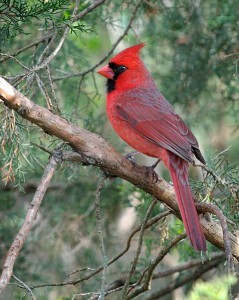Much to the chagrin of the rest of the nation, spring comes in February here in Florida. 2014 saw some bitterly cold weather for most of the country, the result of extreme weather events. Florida managed to avoid most of the problems associated with these events (and hopefully this will continue!)
Florida’s wildlife seems to be keeping to their schedules, despite the cold snaps. By the end of January male Northern Cardinals (Cardinalis cardihalis) had begun their territorial calls, advertising for a mate. This will continue, as the Northern Cardinal begins nesting in March and continues until late summer. As many as four clutches of chicks may be raised during this time! Provide thickets of shrubs from 3 – 20 feet above ground to allow these birds to construct their nests in your yard. Each clutch is raised in a new nest; the male may tend to the nestlings while the female begins a new nest.
Other bird happenings include the beginning of Eastern Screech Owl (Megascops asio) nesting. These little owls make their nests in hollows of trees, and in nest boxes. Providing a nest box is a good way to attract these charming birds to your yard. Have a mouse problem? You may just have an owl deficiency! Listen for their distinctive whinnying call and long, drawn-out trill.
You may notice lots of Red-shouldered Hawks (Buteo lineatus) perching on poles and power lines this month. They too are setting up home. Red-shouldered Hawks prefer to nest in Cypress (Taxodium spp.) but will nest in tall pines, and oaks.
Those large mounds of sand on the side of the road that seem to come from nowhere; those are thanks to the Pocket Gopher (Geomys pinetis). These tunneling rodents chew and claw through sandy soils, pushing up sand mounds as they go. Although they are usually solitary, this month marks the one time during the year that they become semi-social as this is the time mating occurs.
Some of Central Florida’s native plants are also going through changes this month. February marks the end of the Red Maple’s (Acer rubrum) flowering season. The unique fruits (samaras) are ripening, ready to fly to the ground, spinning as they go.
Visit Brooker Creek Preserve this month to observe the many changes our native ecosystems are going through this month!
Resources:
University of Florida Wildlife Extension, Wildlife Happenings, wec.ufl.edu
Stevenson and Anderson, The Birdlife of Florida, University Press of Florida, 1994
Florida Fish and Wildlife Conservation Commission, Pocket Gopher, myfwc.com
 0
0

